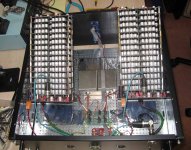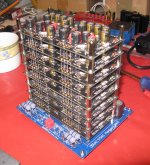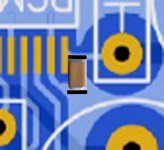Hi Kartick,Hello Guys - I have been a very happy user of the DDDAC 1794 from India.
I am a noob who has probably done a short somewhere in the circuit. I will be keen on your knowledge to point out what I can do to rectify this issue. Please help.
This doesn't sound good to me
What do you mean here? Which resistors did you have fitted when you get this measurement?The voltage between common -pos and neg is 8v.
If the i/v resistor value is correct I would expect to see approx 2.7v here
With the new resistors fitted, what do you measure in ohms between pos-common and neg-common?
Last edited:
Hi Kartick,
This doesn't sound good to meI would think if you have accidentally applied voltage into the output then there is a good chance the dac chip could be damaged...
Hey, thanks for your response. This doesn't sound good. Is there a possibility that the damage could be in the power supply section on the main red board instead? If not, there is anything that I can do to find out which DAC chip on which board could have been impacted?
What should be my next steps here? Appreciate if you can tell me considering I am not very good with technical stuff.
What do you mean here? Which resistors did you have fitted when you get this measurement?
If the i/v resistor value is correct I would expect to see approx 2.7v here
With the new resistors fitted, what do you measure in ohms between pos-common and neg-common?
Sry James.
It's possible I remember wrong about the voltage with the four tantalums, more likely it should be 0.8 v. Since the sound level is to low. ( can't check, they are unsoldered now)
The four tantalums are replaced with the eight dale resistors and everything is fine. Great sound and measuring 2.7v, common-pos, common-neg.
It seems that in my dac with 8 boards, for some reason 4 resistors will not work.
I wonder why ?
Ps; I used four boards with four 33ohm resistors, without any problem
Last edited:
Sry James.
It's possible I remember wrong about the voltage with the four tantalums, more likely it should be 0.8 v. Since the sound level is to low. ( can't check, they are unsoldered now)
The four tantalums are replaced with the eight dale resistors and everything is fine. Great sound and measuring 2.7v, common-pos, common-neg.
It seems that in my dac with 8 boards, for some reason 4 resistors will not work.
I wonder why ?
Ps; I used four boards with four 33ohm resistors, without any problem
I would get the meter out and have a measuring session to find out what is going wrong.
When I ran 8 dac boards, I used 4 off Shinkoh 2w 16R and all worked fine. Have you got the red or blue main board, I failed to get 8 dac boards going with the red board ....
Attachments
@Smooth Dancer:
I think I have a possible explanation for you:
With eight boards you have twice the current Running throuh
The resistors. So if you Running 1/4W resistors you might
Touch the power Limit. You could use 8 resistors instead which
Doubles the Max power.
Regards
Michael
I think I have a possible explanation for you:
With eight boards you have twice the current Running throuh
The resistors. So if you Running 1/4W resistors you might
Touch the power Limit. You could use 8 resistors instead which
Doubles the Max power.
Regards
Michael
As I wrote in the Moode Audio topic, I'm having problems with Hifiberry DAC+pro connected to DDDAC via I2S. I can't get stereo sound from red book material (16bit/44.1kHz), only mono and a little distorted. Highres and mp3 files are ok. Does anybody here have similar experiences and possible solution? I managed to find this discussion from Rune Audio forum and on second page there's one possible solution presented: RuneAudio with RaspberryPI and DDDAC1794-NOS : DIY and tweaks • RuneAudio Forum
Last edited:
Hi Morde,
Do you really connect Hifiberry DAC+pro with DDDAC via I2S, or do you mean RPI and DDDAC?
In case of RPI, I think I have had the same issue in the past like you.
See:
http://www.diyaudio.com/forums/digi...pcm1794-waveio-usb-input-468.html#post4355732
I think mp3 and Highres are always played with 24bit. This is why it is running with these formats without doing anything. My workaround for redbook was to set 'resampling' option in Volumio to force 24bit output (should be the same for RuneAudio).
There was a reply to my post in past with same recommendations like in your link, but I couldn't manage to fix my problem with these settings.
Since I'm running Wave I/O I have not tried with RPI anymore.
Michl
Do you really connect Hifiberry DAC+pro with DDDAC via I2S, or do you mean RPI and DDDAC?
In case of RPI, I think I have had the same issue in the past like you.
See:
http://www.diyaudio.com/forums/digi...pcm1794-waveio-usb-input-468.html#post4355732
I think mp3 and Highres are always played with 24bit. This is why it is running with these formats without doing anything. My workaround for redbook was to set 'resampling' option in Volumio to force 24bit output (should be the same for RuneAudio).
There was a reply to my post in past with same recommendations like in your link, but I couldn't manage to fix my problem with these settings.
Since I'm running Wave I/O I have not tried with RPI anymore.
Michl
Hello Michl.
Thanks for your input. Maybe I'll give it a go and try to install those PCM1794a drivers.
I'm trying to use the DAC+pro board as a reclocker for the I2S signals, because I've read in many places in the web that RPI's I2S is quite jittery. And also I'm trying to avoid the use of computer as a source, so that's why I don't fancy the Wave IO.
-Martti
Thanks for your input. Maybe I'll give it a go and try to install those PCM1794a drivers.
I'm trying to use the DAC+pro board as a reclocker for the I2S signals, because I've read in many places in the web that RPI's I2S is quite jittery. And also I'm trying to avoid the use of computer as a source, so that's why I don't fancy the Wave IO.
-Martti
RPi i2s sounds surprisingly good considering there's no fancy clocks or anything. It's worth having an Isolator of some sort between the rPi and dac though.Hello Michl.
Thanks for your input. Maybe I'll give it a go and try to install those PCM1794a drivers.
I'm trying to use the DAC+pro board as a reclocker for the I2S signals, because I've read in many places in the web that RPI's I2S is quite jittery. And also I'm trying to avoid the use of computer as a source, so that's why I don't fancy the Wave IO.
-Martti
If you want a small low cost computer device with decent reclocking options, the beaglebone black is only slightly more expensive than the rPi but has software which means it can support external audio clocks. If you join a beaglebone black with a decent reclocking board like the Acko s03 or twisted pear cronus and hermes the results can be wonderful
Potential idiotic questions alert, I have zero electrical engineering skills...
Looking at the 1794 webshop it appears there's a semi assembled kit, am I right in thinking there was for a while an option to purchase a fully assembled one?
Is there any third party build services which I can rest assured will do a flawless job and isn't too expensive?
Thanks.
Looking at the 1794 webshop it appears there's a semi assembled kit, am I right in thinking there was for a while an option to purchase a fully assembled one?
Is there any third party build services which I can rest assured will do a flawless job and isn't too expensive?
Thanks.
Ok, so I know I've crossed the line from modification to bastardasiation, but this week i got some of these
100nf c0g smd capacitor in 1206 size to replace the Wima film caps

Scratched some points through the solder mask onto the copper underneath to solder them in (this is a test on a spare board)

Got the tiny soldering iron tip, the solder paste and the jewelry loupe and had a play like this

What a fiddly job!


This is probably a little above the limit of my soldering skills but I got there in the end and did loads of continuity testing to be sure I had no shorts


Well I'm pretty pleased with the results. With this and the Cronus giving the reclocked right justified signal the sound is really open and natural. Textures are really obvious and floaty ambient sections are really airy. Lovely
Thanks again to jptz for the inspiration
In other news, let's talk vcom.. has anyone played with the vcom caps much? I think the consensus was that the vcom affected sound quality and tone and the general noise floor. Silmic gives a nice rich tone, Oscons are accurate but a bit cold. Does anyone have any other alternatives or has tried in combination with bypass caps?
I was checking the pcm1794 datasheet today cos I'm interesting like that... and spotted a recommended layout with both vcom pins joined to a single 47uf cap

I've given this a quick try with bridging the little vias for the vcom and removing one of the caps on each channel. Can't say if there's an improvement but noticed no Ill effects to the sound. Anyone else tried this? Maybe now I can run silmic and Oscon at the same time...
100nf c0g smd capacitor in 1206 size to replace the Wima film caps

Scratched some points through the solder mask onto the copper underneath to solder them in (this is a test on a spare board)

Got the tiny soldering iron tip, the solder paste and the jewelry loupe and had a play like this

What a fiddly job!


This is probably a little above the limit of my soldering skills but I got there in the end and did loads of continuity testing to be sure I had no shorts


Well I'm pretty pleased with the results. With this and the Cronus giving the reclocked right justified signal the sound is really open and natural. Textures are really obvious and floaty ambient sections are really airy. Lovely
Thanks again to jptz for the inspiration
In other news, let's talk vcom.. has anyone played with the vcom caps much? I think the consensus was that the vcom affected sound quality and tone and the general noise floor. Silmic gives a nice rich tone, Oscons are accurate but a bit cold. Does anyone have any other alternatives or has tried in combination with bypass caps?
I was checking the pcm1794 datasheet today cos I'm interesting like that... and spotted a recommended layout with both vcom pins joined to a single 47uf cap

I've given this a quick try with bridging the little vias for the vcom and removing one of the caps on each channel. Can't say if there's an improvement but noticed no Ill effects to the sound. Anyone else tried this? Maybe now I can run silmic and Oscon at the same time...
Last edited:
RPi i2s sounds surprisingly good considering there's no fancy clocks or anything. It's worth having an Isolator of some sort between the rPi and dac though.
If you want a small low cost computer device with decent reclocking options, the beaglebone black is only slightly more expensive than the rPi but has software which means it can support external audio clocks. If you join a beaglebone black with a decent reclocking board like the Acko s03 or twisted pear cronus and hermes the results can be wonderful
Thanks for your hints. I think I might wait for Ian's Rpi goodies to be published: http://www.diyaudio.com/forums/pc-b...-i2s-dsd-isolator-hat-native-dsd-decoder.html
In the mean time I'll probably just try to force the output to 24bits in Moode Audio, just as member Michl has done. It's just a bit dumb thing thing to do considering, that DDDAC is a NOS device and now I have to do 16 to 24 bit conversion in software.
Try this - the solder (black lines) should cover the full width of the COG and the full width of the PCB tracks that you scraped the paint off; the soldered area should be as large as possible. You will definitely notice the difference.
Let us know...
NOTE: not to scale..
Attachments
Ok, so I know I've crossed the line from modification to bastardasiation, but this week i got some of these
100nf c0g smd capacitor in 1206 size to replace the Wima film caps

Scratched some points through the solder mask onto the copper underneath to solder them in (this is a test on a spare board)

Got the tiny soldering iron tip, the solder paste and the jewelry loupe and had a play like this

What a fiddly job!


This is probably a little above the limit of my soldering skills but I got there in the end and did loads of continuity testing to be sure I had no shorts


Well I'm pretty pleased with the results. With this and the Cronus giving the reclocked right justified signal the sound is really open and natural. Textures are really obvious and floaty ambient sections are really airy. Lovely
Thanks again to jptz for the inspiration
In other news, let's talk vcom.. has anyone played with the vcom caps much? I think the consensus was that the vcom affected sound quality and tone and the general noise floor. Silmic gives a nice rich tone, Oscons are accurate but a bit cold. Does anyone have any other alternatives or has tried in combination with bypass caps?
I was checking the pcm1794 datasheet today cos I'm interesting like that... and spotted a recommended layout with both vcom pins joined to a single 47uf cap

I've given this a quick try with bridging the little vias for the vcom and removing one of the caps on each channel. Can't say if there's an improvement but noticed no Ill effects to the sound. Anyone else tried this? Maybe now I can run silmic and Oscon at the same time...
I'm using Black Gates with great effect on V Com positions.
- Home
- Source & Line
- Digital Line Level
- A NOS 192/24 DAC with the PCM1794 (and WaveIO USB input)


